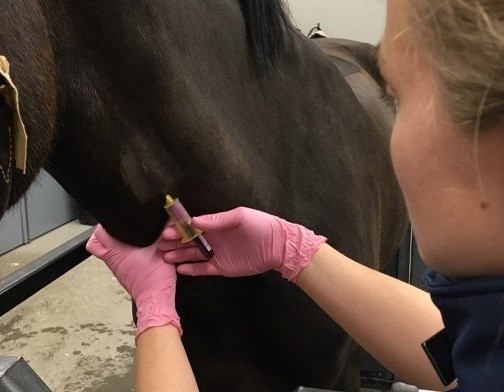Contact
Stina Ekman
Professor at the Department of Biomedical Science and Veterinary Public Health; Pathology Unit
Telephone: +4618671191. E-mail: stina.ekman@slu.se

Molecular serum markers that can identify early reversible osteoarthritis (OA) in horses are lacking. Researchers from the Swedish University of Agricultural Sciences studied serum concentrations of a novel cartilage oligomeric matrix protein (COMP) neo‐epitope in horses subjected to short‐term exercise and with acute lameness. The effects of circadian rhythm and age were also evaluated.
Longitudinal studies in healthy horses and cross‐sectional comparison of lame and non‐lame horses.
Sera were collected from five horses before and after short‐term interval exercise and during full‐day box rest. Sera from 32 acutely lame horses were used to evaluate age‐related effects. Independent samples from control horses (n = 41) and horses with acute lameness (n = 71) were included. COMP neo‐epitope concentrations were analysed using custom‐developed inhibition ELISAs validated for equine serum. The presence of COMP neo‐epitope was delineated in healthy and osteoarthritic articular cartilage with immunohistochemistry.
COMP neo‐epitope concentrations decreased after speed training but returned to baseline levels post‐exercise. No correlations between age and serum COMP neo‐epitope concentrations were found (r = 0.0013). The mean (±s.d.) serum concentration of COMP neo‐epitope in independent samples from non‐lame horses was 0.84 ± 0.38 μg/mL, and for lame horses was 5.24 ± 1.83 μg/mL (P<0.001). Antibodies against COMP neo‐epitope did not stain normal articular cartilage, but intracytoplasmic staining was found in superficial chondrocytes of mild OA cartilage and in the extracellular matrix of moderately osteoarthritic cartilage.
ELISA was based on polyclonal antisera rather than a monoclonal antibody. There is a sex and breed bias within the groups of horses, also it could have been of value to include horses with septic arthritis and tendonitis and investigated joint differences.
This COMP neo‐epitope can be measured in sera, and results indicate that it could be a biomarker for pathologic fragmentation of cartilage in connection with acute joint lameness.
https://doi.org/10.1111/evj.13082
Ekman S, Lindahl A, Rüetschi U, Jansson A, Björkman K, Abrahamsson-Aurell K, Björnsdóttir S, Löfgren M, Hultén LM, Skiöldebrand E. "Effect of circadian rhythm, age, training and acute lameness on serum concentrations of cartilage oligomeric matrix protein (COMP) neo-epitope in horses". Equine Vet J. 2019 Sep;51(5):674-680.
Stina Ekman
Professor at the Department of Biomedical Science and Veterinary Public Health; Pathology Unit
Telephone: +4618671191. E-mail: stina.ekman@slu.se